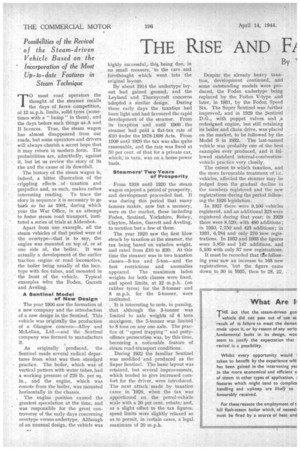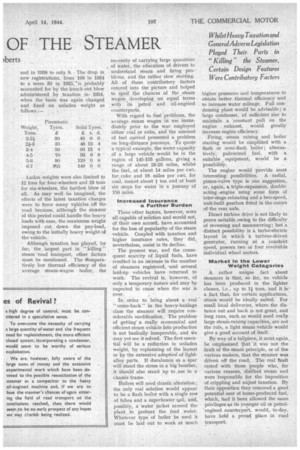THE RISE AND Fi OF THE STEAMER
Page 26

Page 27

If you've noticed an error in this article please click here to report it so we can fix it.
T0 most road operators the thought. of the steamer recalls the days of fierce competition, of 12 m.p.h. limits, solid tyres (sometimes with a "bump " in them), and the days before such things as A and B licences. True, the steam wagon has almost disappeared from our roads, but some operators and drivers will always cherish a secret hope that it may return in modern form. The probabilities are, admittedly, against it, but let us review the story of its rise and the cause of its downfall.
The history of the steam wagon is, indeed, a bitter illustration of the crippling effects of. taxation and prejudice and, as such, makes rather interesting reading. To trace the story in sequence it is necessary to go back so far as 1901, during which year the War Office, in an attempt to foster steam road transport, instituted a series of trials at Aldershot.
Apart from one example, all the steam vehicles of that period were of the overtype—that is to say, the engine was mounted on top of, or at one side of, the boiler. It was actually a development of the earlier traction engine or road locomotive, the boiler being usually of the loco. type with fire tubes, and mounted in the front of the vehicle. Typical examples ive're the Foden, Garrett and Aveling.
A Sentinel Model • of New Design
The year 1900 saw the formation of a new company and the introduction of a new design in the Sentinel. This vehicle was originally the production of a Glasgow concern—Alley and McLellan, Ltd.—and the ,Sentinel company was formed to manufacture it. , As originally •produced, the Sentinel made several radical departures from what was then standard practice. The boiler, which was of vertical pattern with water tubes, had a working pressure of 220 lb. per sq. in., and the engine, which was remote from the boiler, was mounted horizontally in the chassis. .
. The engine position caused the greatest speculation at the time, and was responsible for the great controversy of the early days concerning overtype versus undertype. Although of an unusual design, Ihe vehicle was ... highly successful„ this being due, in no small measure, to the care and forethought which went into the original layout.
By about 1914 the undertype layout had gained ground, and the Leyland and Thornyeroft concerns 'adopted a similar design. During these early days the taxation had been light and had favoured the rapid development of the steamer. From its inception and until 1909 . the steamer had paid a flat-tax rate of £10 finder the 1878-1898 Acts. From 1009 until 1920 the tax was also quite reasonable, and the rate was fixed at 50 per cent, of that for a private car, which, in turn, was on a horse-power basis.
Steamers' Two Years of Prosperity
From 1918 until 1920 the steant wagon enjoyed a period of prosperity, and development proceeded fast. It was during this period that many famous makes, now but a memory, were on the market, these including Foden, Sentinel, Yorkshire, Robey, Clayton, Mann, Garrett and Aveling, to mention but a few of them.
The year 1920 saw the first blow struck by taxation at the steamer, the tax being. based on unladen weight, and rated from £10 to 130. At this time the steamer was in two taxation classes-3-ton and 5-ton—and the first restrictions and anomalies appeared. The maximum laden weights for both classes were fixed, and speed limits, at 12 m.p.h. (on rubber tyres) for the 3-tonner and 8 m.p.h. for the 5-tonner, were instituted.
, It is interesting to note, in passing, that although the 3-tonner was limited to axle weights of 6 tons maxiwum, the 5-tonner was limited to 8 tons on any one axle. The practice of "speed trapping" and pettyoffence persecution was, by this time, becoming a noticeable feature of steam road-transport conditions.
During 1922 the familiar Sentinel was modified. and produced as the Super Sentinel. The basic layout was retained, but several improvements, which tended to give increased comfort for the driver, were introduced. The next attack made by taxation came in 1926, when the tax was apportioned on the petrol-vehicle scale with a 20 per cent. rebate,. and, as a slight offset to the tax figures, speed limits were slightly relaxed so as to permit, in certain cases, a legal maximum of 20 rn.p.h.
Despite. the already heavy taxation, development continued, and some outstanding models were produced, the Foden undertype being replaced by the Foden V-type and later, in 1931, by the Foden. Speed Six. The Super Sentinel was further improved; and in 1929 the ,Sentinel D.G., with poppet valves and ,a redesigned engine, but still retaining its boiler and chain drive, was' placed on the market; to be followed by the Model S in 1932. The last-named vehicle was probably one of the best examples ever produced, and it followed standard internal-combustionvehicle practice very closely.
The extent to. which taxation, and the more favourable treatment of i.c. vehicles, affected the steamer 'may be judged from the gradual decline in the numbers registered and the new registrations during the period following the 1926 legislation.
In 1927 there were 9,100 vehicles registered, and an additional 323 were registered during that year; in 1929 there were 8,520,with 480 additions ; in 1930, 7,750 and 423 additions ; in 1931, 6,784 and only 270 new registrations. In 1932 and 1033 the figures were 5,850 and i.47 additions, and 5,100 with only 37 new registrations.
It must be recorded that tlSe following year saw an increase to 168 new registrations, but the figure came down to 30 in 1035, then to 28, 22, and in 1938 to only 8. The drop in new registrations, from 168 in 1934 to a mere 30 in 1935; 'is probably accounted for by the.knock-Out blow administered by taxation in 1934, when the basis was again changed and fixed on unladen weight as follows :- Laden weights were also limited to • 12 tons for four-wheelers and 19 tons for six-wheelers, the hardest blow of all. As may well be imagined, the effects of the latest taxation charges were to force many vvhicles off the road because, although the steamer of this period could handle the heavy loads with ease, the maximum weight imposed cut down the pay-load, owing to the initially heavy weight of the vehicle.
Although taxation has played, by far, the, largest part in " killing " steam road transport, other factors must be mentioned. The dbmparatively low thermal efficiency of the average steam-wagon boiler, the necessity of carrying large quantities of water, the education of drivers to understand steam and firing pro-j blems, and the rather slow starting. All of these contributory factors entered into the picture and helped to spoil the chances of the., steam wagon, developing, on equal terms with its petrol and oil-engined co unterparts.
With regard to fuel problems, the average steam wagon in use immediately prior to the war employed either coal or coke, and the amount of fuel carried presented a problem on long-distance journeys. To quote a typical example, the water capacity of a large vehicle would be in the region of 145-155 gallons, giving a range of about 26-28 miles, whilst the fuel, at about 14 miles per cwt. for coke and 18 miles per cwt. for coal, meant about 1 ton and at least six stops for water in a journey Of 150 miles.
Increased Insurance • a Further Burden
These other factors, however, were all capable of solution and would not, of their own accord, have accounted for the loss of popularity of the steam vehicle. Coupled with taxation and higher insutance rates, they did, nevertheless, assist in its decline.
The 'present war, and the consequent scarcity of liquid fuels, have resulted in an increase in the number of steamers registered, -and several laid-up vehicles have returned to work. The revival is, however, of only a temporary nature and may bp expected to cease when the war is over.
In. order to bring about a real " come-back " in the heavy-haulage class the steamer will require considerable modification. The problem of getting a really economital and efficient steam vehicle into production is not basically insuperable, and lie may yet see it solved. The first essential will be a reduction in unladen weight, by replanning of the layout or by the extensive adoption of lightalloy parts. If duralumin as a spar will stand the stress in a big bomber, it should also stand up to, use in a chassis frame. • Boilers will need drastic alteration ; the only real solution would appear to be a flash boiler with a single row of tubes and a superheater coil, and, possibly, a water jacket around the plant to preheat the feed water. Whatever type of boiler be used it must be laid out to work at much higher pressures and temperatures to obtain better thermal efficiency and to increase water mileage. Full condensing plant would be advisable ; a large condenser, of sufficient size to maintain a constant pull on the engine exhaust, would greatly increase engine efficiency.
Firing, steath raising and boiler starting would be simplified with a flash or semi-flash boiler alternatively, pulverized fuel, with a suitable equipment, would be a
The engine would 'provide most interesting possibilities. A radial, piston-valve type is one suggestion, or, again, a. triple-expansion, double-acting ,-engine using some form of inter-stage reheating and a two-speed, unit-built gearbox fitted in the centre of the rear axle.
Direct turbine drive is not likely to prove suitable owing to the difficulty of reversing and trianceuvring ; but a distinct possibility is a turbo-electric layout in which a turbine-driven generator, running at a constant speed, powers two or four reversible individual wheel motors.
Market In the Lower Weight Catagories
A rather unique fact about steamers is that, so far, no vehicle has been produced in the lighter classes, i.e., up to 11 tons, and it is a fact that, for certain applications, steam would be ideally suited. For small local deliveries, where the distance out and back is not great, and long runs,_ such as would need really large steam-raising capacities, are not the rule, a light steam vehicle would give a good account of itself.
By way of a tailpiece, it must again, be emphasized that it was not the fault of the steam principle, or of the various makers, that the steamer was driven off the road. The real fault rested with those people who, for various reasons,' disliked steam and were responsible for the imposition of crippling and unjust taxation. By their opposition they removed a good potential user of home-produced fuel, which, had it been allowed the same privileges as its younger oil or petrol"engined counterpart, would, to-day, have held a proud place in road transport.




















































